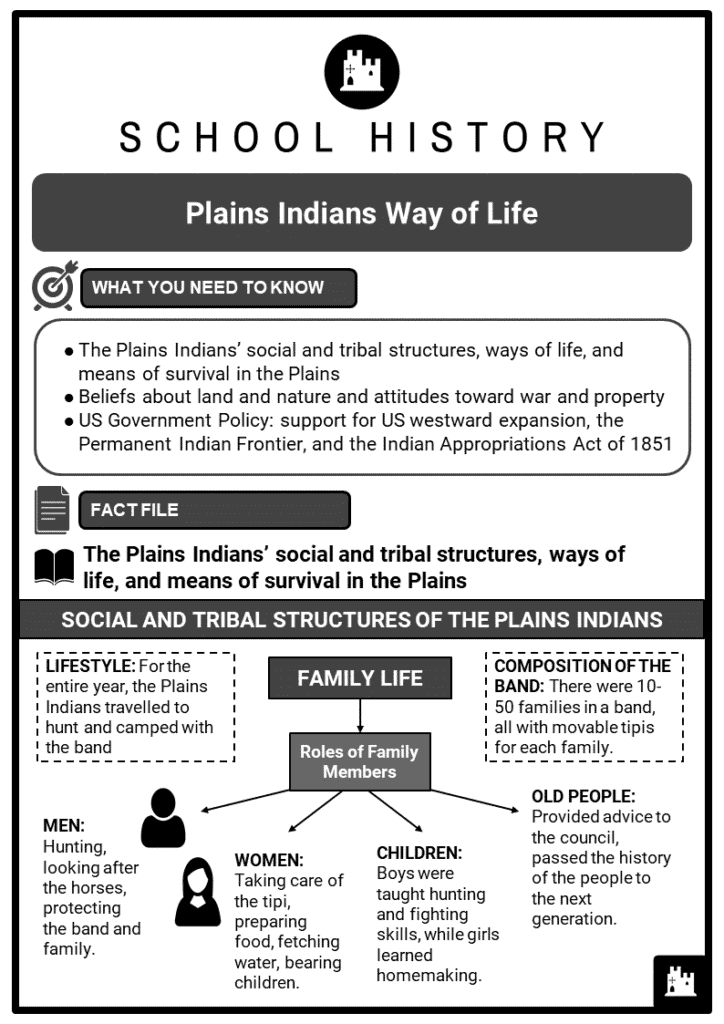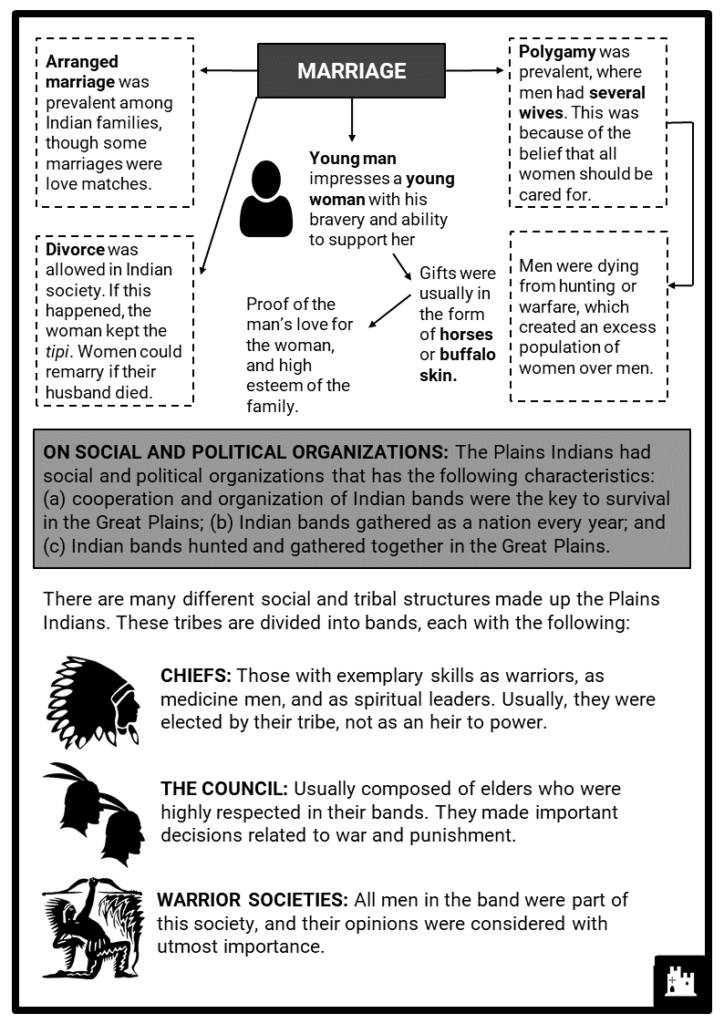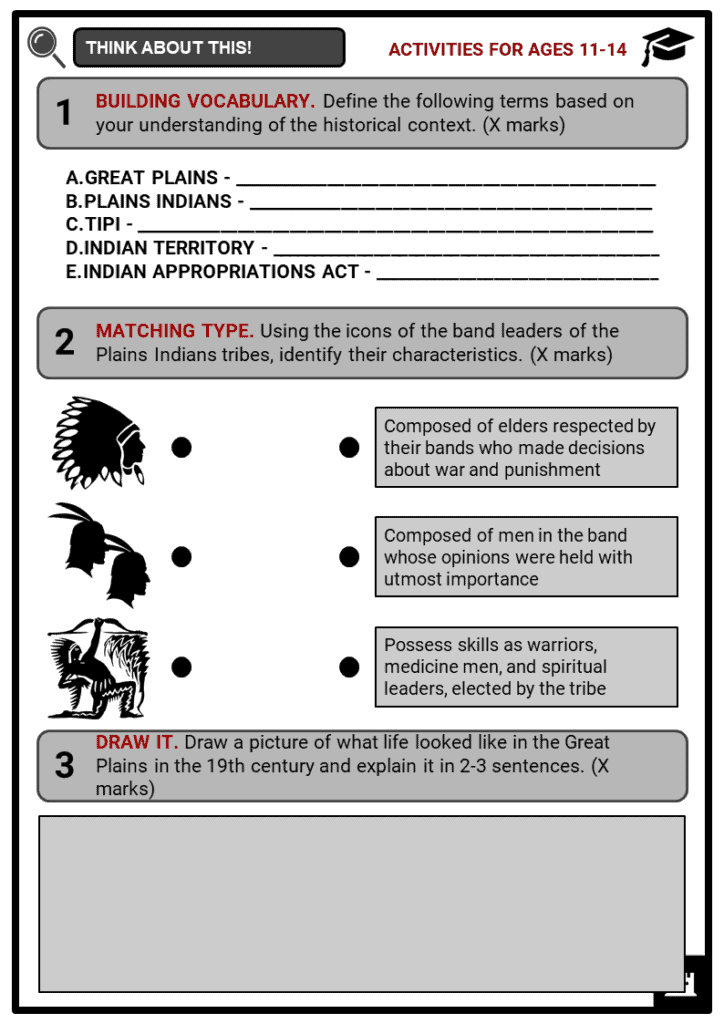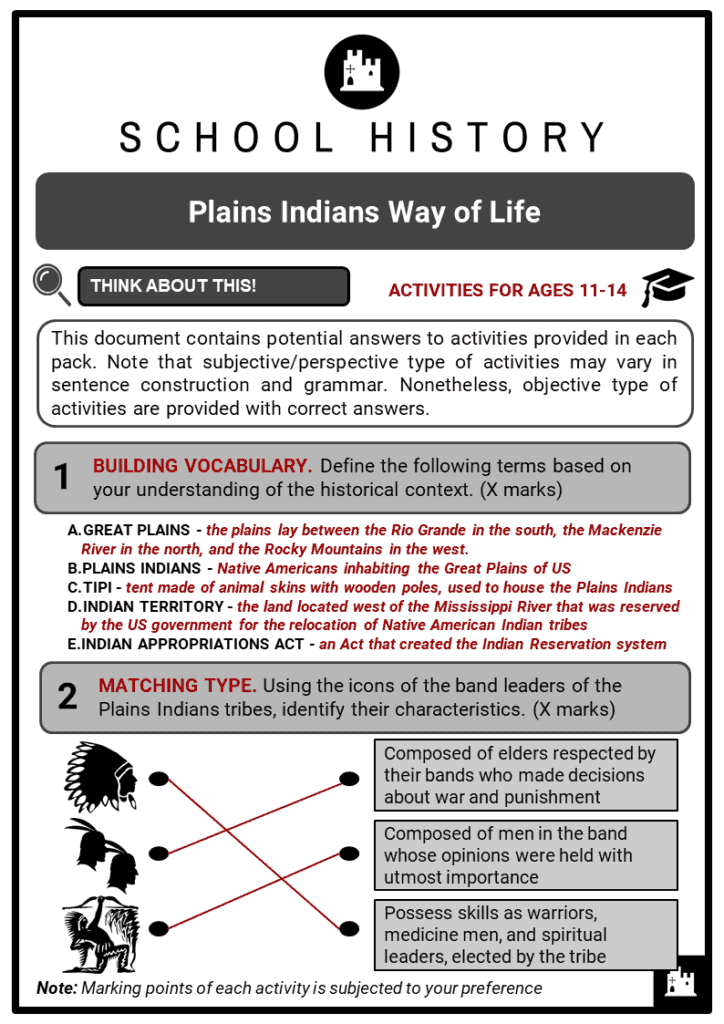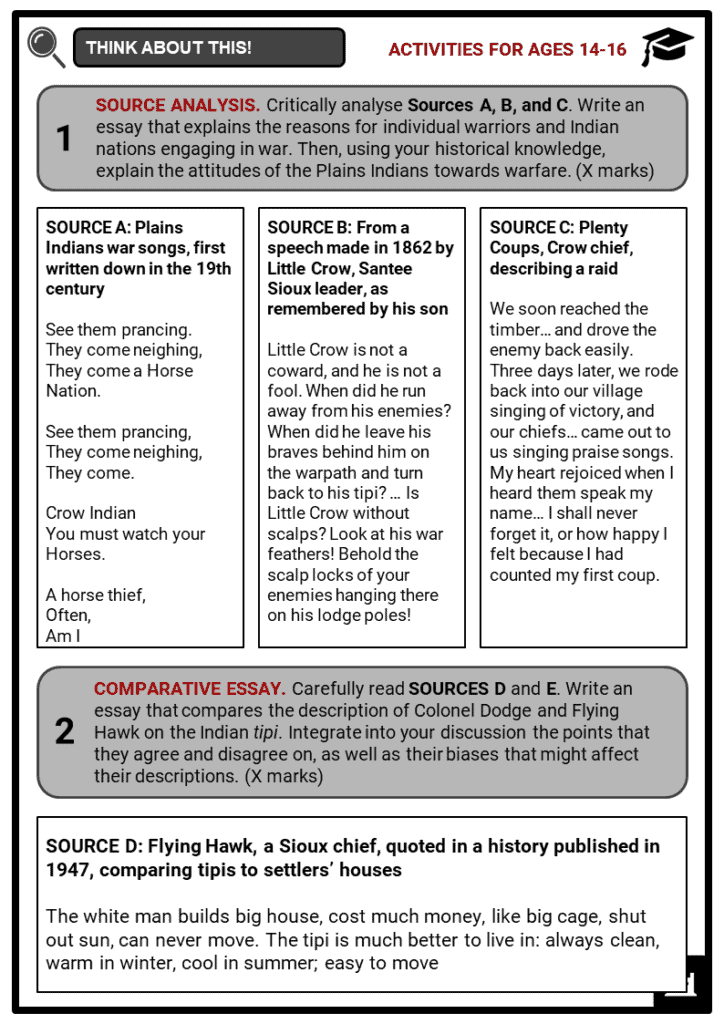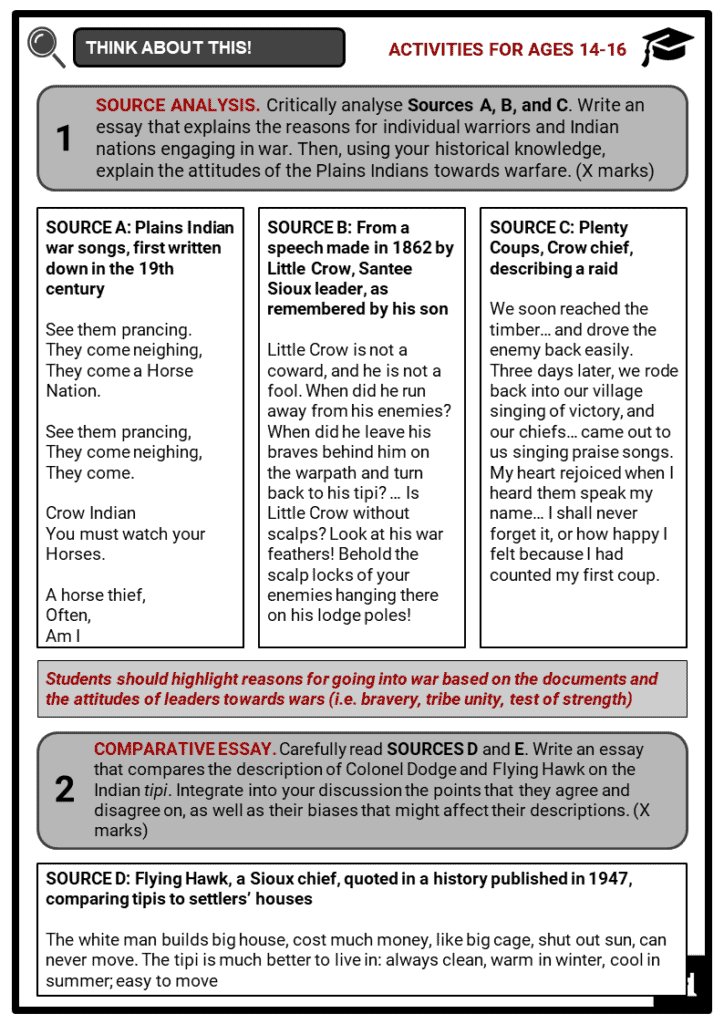Download Plains Indians Way of Life Worksheets
Do you want to save dozens of hours in time? Get your evenings and weekends back? Be able to teach Plains Indians Way of Life to your students?
Our worksheet bundle includes a fact file and printable worksheets and student activities. Perfect for both the classroom and homeschooling!
Table of Contents
Add a header to begin generating the table of contents
Summary
- The Plains Indians’ social and tribal structures, ways of life, and means of survival in the Plains
- Beliefs about land and nature and attitudes toward war and property
- US Government Policy: support for US westward expansion, the Permanent Indian Frontier, and the Indian Appropriations Act of 1851
Key Facts And Information
Social And Tribal Structures Of The Plains Indians
- LIFESTYLE: For the entire year, the Plains Indians travelled to hunt and camped with the band
- COMPOSITION OF THE BAND: There were 10-50 families in a band, all with movable tipis for each family.
- Roles of Family Members
- MEN: Hunting, looking after the horses, protecting the band and family.
- WOMEN: Taking care of the tipi, preparing food, fetching water, bearing children.
- CHILDREN: Boys were taught hunting and fighting skills, while girls learned homemaking.
- OLD PEOPLE: Provided advice to the council, passed the history of the people to the next generation.
- MARRIAGE
- Arranged marriage was prevalent among Indian families, though some marriages were love matches.
- Divorce was allowed in Indian society. If this happened, the woman kept the tipi. Women could remarry if their husband died.
- Young man impresses a young woman with his bravery and ability to support her
- Gifts were usually in the form of horses or buffalo skin.
- Proof of the man’s love for the woman, and high esteem of the family.
- Polygamy was prevalent, where men had several wives. This was because of the belief that all women should be cared for.
- Men were dying from hunting or warfare, which created an excess population of women over men.
- ON SOCIAL AND POLITICAL ORGANIZATIONS:
- The Plains Indians had social and political organizations that has the following characteristics: (a) cooperation and organization of Indian bands were the key to survival in the Great Plains; (b) Indian bands gathered as a nation every year; and (c) Indian bands hunted and gathered together in the Great Plains.
- There are many different social and tribal structures made up the Plains Indians. These tribes are divided into bands, each with the following:
- CHIEFS: Those with exemplary skills as warriors, as medicine men, and as spiritual leaders. Usually, they were elected by their tribe, not as an heir to power.
- THE COUNCIL: Usually composed of elders who were highly respected in their bands. They made important decisions related to war and punishment.
- WARRIOR SOCIETIES: All men in the band were part of this society, and their opinions were considered with utmost importance.
The Plains Indians’ Ways Of Life And Means Of Survival
- THE IMPORTANCE OF HORSES:
- The first horses were brought to America by the Spanish colonists during the 16th century. In 1640, the Pueblo Indians of Mexico captured these horses from the Spaniards and took care of them through breeding and trading with other Indian nations.
- Indians saw horses as a way for them to survive in the Plains. They were used during warfare.
- Social status and wealth were determined by the number of horses that a person or tribe had.
- Indians would ride horses to hunt for buffalo.
- Horses served as a mode of transportation to various places in the Plains since they were nomadic people.
- THE IMPORTANCE OF BUFFALO:
- Buffalo were hunted for living and survival, not farmed or bred. Before hunting, the Plains Indians performed several days of dance rituals by dressing like a buffalo and copying their movements to help them hunt more buffalo along their journey.
- Parts of the buffalo were used for food, clothing, and equipment for tipis.
- The heart of a buffalo was left in the Plains, following the belief that it would give a new life to a herd.
- After the hunt, women and children prepared the carcass for eating raw or cooked.
- Jerky from the buffalo meat was stored for consuming during the winter season.
The Uses Of The Buffalo For The Plains Indians
- Buffalo were important to the Plains Indians. In the photo to the left, the South Dakota State Historical Society outlines the different uses of the buffalo for the Plains Indians.
- "The buffalo’s doom is sealed, and with their extinction, the Indians must surely sink into despair and starvation. The Plains offer them no other means of living.” George Catlin
A Look Inside The Structure Of A Tipi
- Two ears or flaps were present on the top of the tipi. This could be moved in the wind’s direction to allow the smoke from the fire to escape.
- The tipi was made from 10-20 buffalo skins sewn together by the women. It was supported by wooden poles arranged in a circle. It is easily movable from one place to another.
- During summer, people could roll up the tipi bottom for airflow, while they could close it during winter to warm up the inside space.
- Inside the tipi, the fire was located at the center to provide heat and to be used for cooking. The floor was covered with furs. The confined space inside a tipi meant strict rules in behaviour, such as entering to the right and not walking between a seated person and the fire (tripping hazard).
On Land, Property, And Nature
- THE SPIRIT WORLD
- Wakan Tanka, or the Great Spirit, was very significant to the Sioux, as he created the world and all life forms on Earth. They also believed that all living things had spirits, and it had influence over their lives as a whole.
- DANCES AND CEREMONIES
- Performing dances and ritual ceremonies was also a way for the Sioux to contact the spirit world. These included buffalo and scalp dances. The sun dance was the most famous dance when bands came together.
- VISIONS
- Visions helped the Sioux in their journey. This was a way for them to contact the spirits. Young men were asked to search for theirs through cleaning their body, praying, and fasting. For women, they developed visions once they reached puberty.
- LAND
- The Plains Indians’ attitude towards land was one of the most misunderstood, and it would later cause tension. They believed that land was part of life itself, and some of it was considered to be sacred. Land could not be owned by any individual.
Attitudes Toward War
- REASONS FOR WARFARE: The Plains Indians engaged in warfare to demonstrate skills, protect hunting grounds, seek revenge or honor, unite the tribe, capture horses or weapons, test strength among chiefs, and gain control over the young and brave men (which is usually done by the elders).
- DEFINING BRAVERY: For the Plains Indians, being brave was to be responsible for one’s actions and to keep yourself alive to provide for the family.
- FIGHTING STYLES AND ATTITUDES: The Plains Indians never engaged in war to own land or destroy or conquer other tribes. They fought in short raids to show bravery. Warriors would gain honor through counting coup (i.e., touching the enemy by hand or stick). Some tribes scalped dead enemies so their spirits would not fight in heaven.
- US Government Policy: Westward expansion, the Permanent Indian Frontier, and the Indian Appropriations Act of 1851
- Before the colonies and the United States were established, the North American territory was originally inhabited by the Indian Nations. They were considered to be sovereign nations but, later on, were seen as “barriers” to US expansion. Through peace treaties, the Indian Nations surrendered some of their land. In 1824, the US War Department created the Bureau of Indian Affairs and tasked them with establishing a partnership between the Indians and the new white settlers.
Indian Removal Act Of 1830
- The establishment of a Permanent Indian Frontier - boundary between the US and the Indian territory. The Indians’ territory shrank as a result of this.
- Removal of southeastern Indian nations from their lands for US expansion. Some removal operations were forced, and thousands died.
The Indian Appropriations Act Of 1851
- 1849: Bureau of Indian Affairs was moved to the Interior Department from the US War Department
- 1850s: Westward movement of the Plains Indians continued, and the US government wanted to “civilise” them.
- “Civilising” the Plains Indians meant putting up schools and settling them into agricultural reservations.
- The Plains Indians were consolidated into agricultural reservations to free up more land for the white settlers to expand their territory and cultivate. Reservations meant that these lands are “reserved” for the Indians and controlled by the US government. White Americans encouraged Indians to live like them. Hunting buffalo beyond their reservations was not allowed, and Indians were forced to farm land allocated to them.

